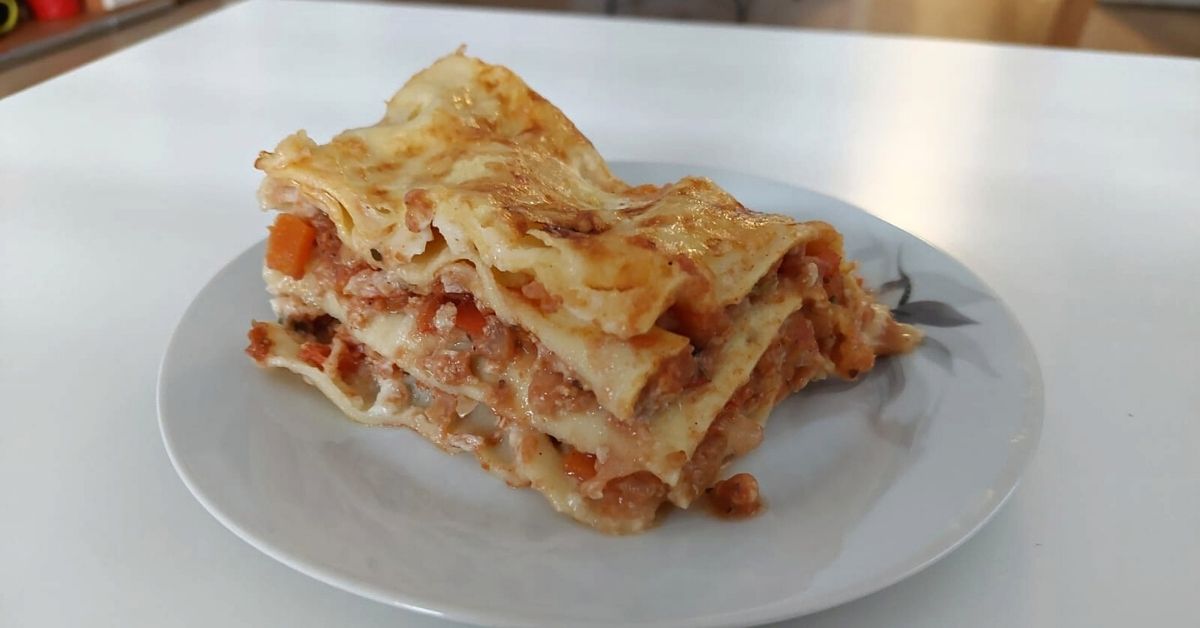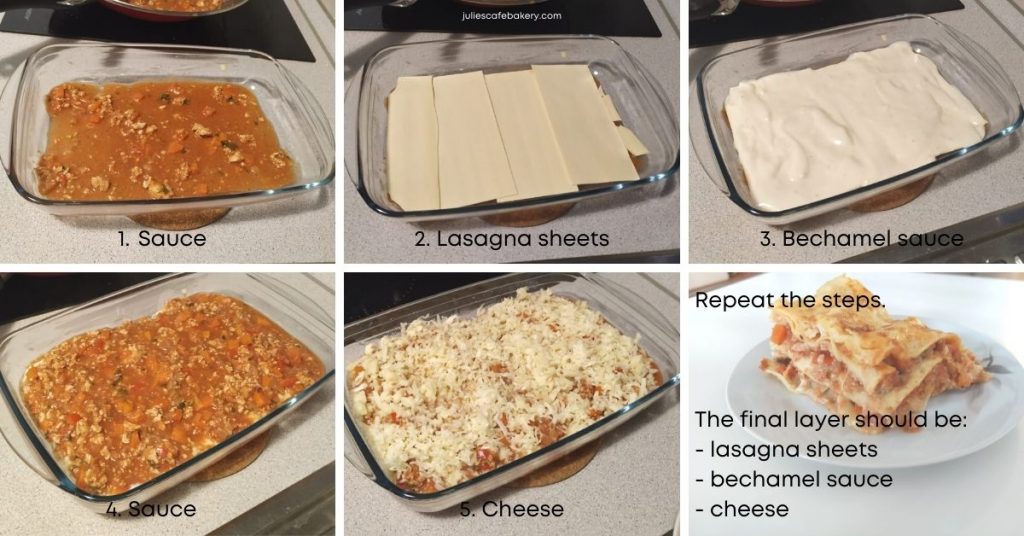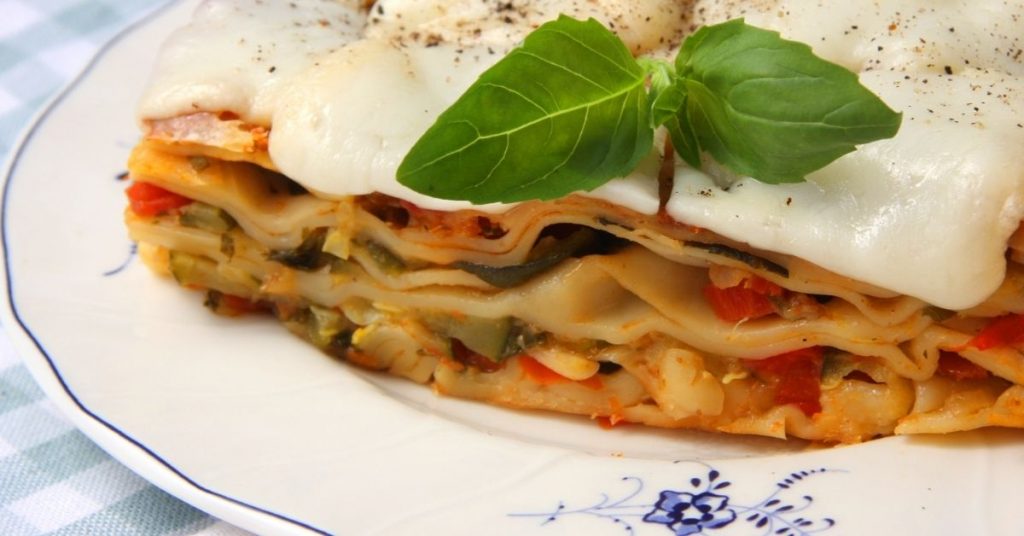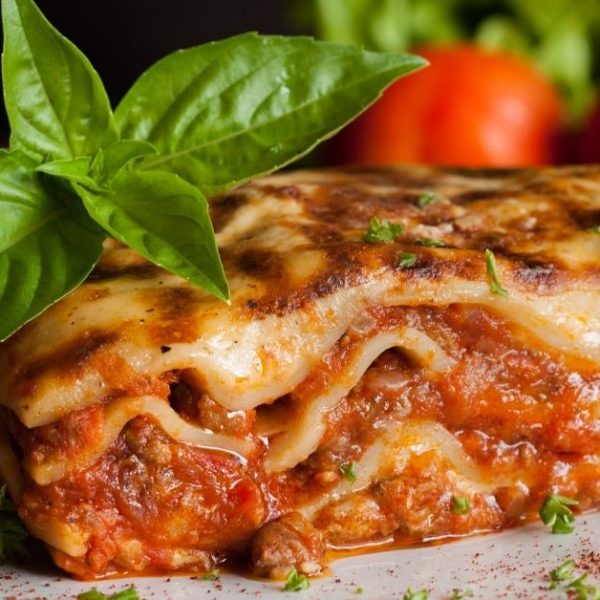How Many Layers Should Lasagna Have? How to Layer It?

Lasagna is a classic pasta dish from Italian cuisine. It has multiple layers of pasta, tomato sauce, and often meat and cheese. But how many layers should a lasagna have? And how should you stack the layers?
Lasagna typically has 3-4 layers but you can add more layers if you want. There need to be at least two layers of pasta to qualify as lasagna. You put a layer of sauce first, cover it with pasta, put bechamel sauce, sauce again, then top it with cheese. Repeat this process till you get the desired number of layers.
From a distance, lasagna may seem like a pretty difficult dish to make. However, if you know the proper way to layer the pasta and incorporate the right ingredients, you will be making delicious lasagna in no time. And in this article, we are going to be discussing all these things and more.
What Is the Minimum Number of Layers in Lasagna?
The whole thing about lasagna is that it is a layered dish. There need to be multiple layers of pasta sheets in between the sauce and other elements.
So, you need at least two layers of pasta and sauce to achieve the concept of a multi-layered pasta dish. Two layers are sort of the most basic lasagna recipe you can make and also the simplest. Typically, you will see a minimum of 3 layers in most lasagna variations. In fact, many people will not consider it a proper lasagna if it has anything less.
But if you want your dish to qualify as a proper lasagna by doing the bare minimum, you will need two layers. Keep in mind that the number of layers may affect how long to bake lasagna in the oven, too. Some take about 45 minutes, while other can be done in 20 minutes.
What Are the Maximum Numbers of Layers in Lasagna?
A lasagna can have as many layers as you want or are capable of making properly. There really is no limit to how many layers you add to a lasagna dish. The original recipes for lasagna do not mandate a limit.
While most people tend to stick with 3 or 4 or even 5 layers, that is mainly done for the sake of convenience rather than a set rule. The more layers you add to the dish, the more challenging it will be for you to cook it and serve it. The bigger the lasagna, the easier it will be for it to fall apart. You would need to be extra careful with a lasagna that has like 7 or 8 layers.
But you can feasibly make lasagna that big. You would need a lot of patience, a huge amount of ingredients, and extra help. And you need to be extra careful when cooking. Otherwise, you may end up with an undercooked lasagna or a lasagna that is disproportionately organized.
However, if you are prepared for the task and have adequate experience and preparation, you can make a lasagna with as many layers as you want. Just make sure you have a large enough tray and have enough sauce to fill the lasagna. There is nothing quite as disappointing as a dry lasagna.
What Is the Proper Way to Layer Lasagna?
Once again, you can arrange a lasagna in whatever order you so desire. There are many variations around the world just based on this factor. Certain people like to layer their lasagna in certain ways.
But there are some generally accepted rules when it comes to building a lasagna. You will probably find that the majority of lasagna dishes follow these rules for the most part.
Take a large enough baking tray that has very high edges. Otherwise, the filling is just going to come out of the lasagna.
A Layer of Tomato Sauce
To begin the process, the first thing you need to apply is a layer of tomato sauce. The sauce can be whatever tomato sauce you fancy. It can be marinara or pasta sauce; it can contain meat and/or vegetables. But the sauce needs to go down on the tray first, so that lasagna noodles won’t stick to the bottom of the pan and won’t be dry.
Traditionally, Italians use the bolognese sauce to make lasagna, but some modern variations include vegan tomato sauce or something similar.
If you want your lasagna to be extra cheesy, add a layer of Gouda or Mozzarella on top of the bolognese sauce. Alternatively, you can put the cheese on bechamel sauce, so that they can blend together while baking in the oven.
A Layer of Lasagna Noodles
Then you should place a layer of lasagna noodles or sheets on top of the sauce so that they cover the whole bottom of the pan.
Bechamel Sauce
Spread the bechamel sauce on the lasagna noodles to get the authentic Italian taste. Some people skip the bechamel sauce. But if you want to make lasagna in the traditional way, I suggest making this simple and creamy sauce.
Everything you need for bechamel sauce is butter, ground nutmeg, flour and milk. Just put the flour on the warm butter and stir constantly until you get the golden color. Add nutmeg and stir some more. Slowly pour in milk while continuously whisking the mixture. Cook the sauce until you get the semi-thick texture.
Repeat
Now, repeat these steps however many times you like until you get multiple layers of tomato sauce, pasta, bechamel sauce and cheese.
Finally, when you reach the top layer, top off the whole thing with more cheese and/or sauce if you feel like it or have any leftovers.
These are the basic steps to making any lasagna. Of course, you are more than welcome to innovate it, add your own spin to it. For example, you may add the cheese only at the end. Or you can add a thin spread of vegetables to each layer. The possibilities are only limited by your imagination honestly. Just make sure that you do not overfill the tray.

How Many Layers Are Best For Lasagna?
The common consensus is that a lasagna should have 3-5 layers. And there are good reasons as to why many people will stay within this limit.
First of all, you have to think about the preparation time. Lasagna traditionally utilizes pasta sauce or a thick tomato-based sauce. And it can take several hours for the sauce to thicken to the right consistency and for the meat to cook through. Not to mention you are going to need generous amounts of each ingredient or the lasagna will not be hearty enough.
The next thing you have to consider is the cooking time. Obviously, the more layers the lasagna will have, the more time it will need to cook through correctly. If you do not bake it for a sufficient time, the center is going to stay raw and end up ruining the entire dish.
Another factor is the way you are going to serve the dish. The larger and more layered the dish is, the more care you have to show when handling it. Otherwise, the lasagna is going to fall apart before you can put it on the plate and create a big mess.
Additionally, if you do not have a large enough baking tray, the filling will likely spill over. So, there is no point in putting extra layers in just to make it look good. You also need to think about the number of pasta sheets at your disposal. Without the sheets, the individual layers will collapse on top of each other and you will end up with soup instead.
But you also want there to be enough layers that satisfy both the mind and the stomach. If you add too few layers, you may not get to use the entire sauce you just made.
So, with all this in mind, the magical number of lasagna layers is probably between 3-5. This will give you plenty of space to work with and not make the dish too daunting of a task. But make sure you check your tools, the amount of sauce, and the number of sheets before you start making the dish. That will ultimately inform you as to how many layers you can make.
How to Layer Vegetable Lasagna?
The basic principles are the same with vegetable lasagna as it is with other types. You should chop the vegetables first into tiny pieces which will help with the cooking and organizing. To save time, you can make a mixture of finely chopped vegetables and cheese in a large bowl. Here is how you do it:
- Start by lathering a generous amount of tomato sauce (or the sauce you prepared) in the bottom of a 9*9-inch dish.
- Top it off with sheets of lasagna noodles. Remember to overlap the edges so that there is no gap.
- Now, add the cheese and vegetable mixture on top of the noodles. Spread it evenly with the back of your spoon.
- Do this process 3 to 4 times to get a multi-layered lasagna ready.
- Finally, you can add the leftover sauce and garnish it with more cheese.
Place it in the oven for baking for about 25 minutes.

What Is Ragu In Lasagna?
When learning about traditional lasagna, you will inevitably come across the term “ragu.” That is because the classic Italian sauce is a frequent companion to lasagna in Italian cuisine.
Essentially, “ragu” in sauce with meat and sautéed vegetables. The most common variety of this dish is called Bolognaise or Bolognese sauce, which is also the type of sauce that frequently pairs with a lasagna dish.
The meat in Ragu is minced or ground beef or pork. Vegetables include onion, celery, carrots, tomatoes, etc. This sauce takes a significant amount of time, several hours of simmering, to cook, or else it will not be thick enough. So, if you are planning on making it for your lasagna, it is best to start early in the morning to get ahead of time.
What Cheese Do You Use in Lasagna?
Cheese is an integral part of most lasagna recipes. It provides a rich, creamy, and salty flavor that perfectly compliments the meat. But with so many cheeses available, it can be frustrating picking one.
Fortunately, that same variation can actually be of use to you. Similar to pizza, you do not have to use just one kind of cheese in your lasagna. Mozzarella, Edam, Gouda, are all excellent choices for making lasagna. But if you feel like it, you can mix and match multiple types of cheese.
Alternatively, if you are on a vegan or vegetarian diet, you can use vegan cheese or sour cream to get that same creaminess.
In the lasagna in the picture below, I used Gouda and Tilsit on every layer of tomato sauce. The final result was a creamy and buttery taste. I loved it!

What Sauce Do You Use in Lasagna?
Traditionally, lasagna is made with bolognese sauce, a meat-based sauce that is accompanied by different vegetables. You can take your time and make a very thick sauce with meat and vegetables. Or you can make something lighter such as marinara sauce to save time.
If you are on a meat-free diet, you can swap out the ground beef for red lentils and tofu. This will still give you the protein without compromising your dietary restrictions.
Does It Matter How You Layer Lasagna?
Stacking the layers of lasagna is like an art and you do have to be mindful of your method. Although you can be flexible with the way you layer a lasagna, there are some guidelines you should adhere to for a quality lasagna. So, yes, it is important how you layer lasagna.
Let’s start at the beginning. The first layer to go down on the pan or tray is the sauce. You may consider putting a layer of noodles initially and then drenching it with sauce. But there are a few problems with that.
Having sauce at the base ensures that the entire lasagna stays moist top to bottom. Moreover, if you put the sheets of pasta first, the sheets may end up sticking to the pan after baking. To avoid these issues, you should place a nice and even spread of sauce before you add anything else.
While it is important to be generous with the sauce, remember that you have multiple layers to play with. So, you should not overload one layer with the sauce as that will result in a very soft and fragile lasagna.
Make sure that the noodles do not have any leaks. Otherwise, the layers are going to mesh with one another and turn into a giant bowl of soup. An easy way to avoid this would be to place the sheets in a manner where the edges overlap, therefore leaving no gaps in between.
Do You Need to Pre-Cook Dry Lasagna Sheets?
The dry lasagna sheets you can buy from stores have two varieties. Some lasagna sheets need to be pre-cooked, and some do not.
If the package specifies that the sheets are “oven-ready” or “no need to pre-cook”, then you can use them directly in the lasagna. This is a great time saver for people who do not have the luxury of making fresh pasta sheets at home.
But if the package does not say this specifically, it is best to pre-boil them before putting them in the lasagna. The reason for this is that dry sheets take a longer time to rehydrate than fresh sheets. And if they do not absorb moisture properly, you will end up with a very dry lasagna.
Fresh lasagna does not have this problem. The moisture from the sauce is enough to make the pasta perfectly edible. Pre-cooking dried pasta sheets is not an absolute requirement. But remember that it will take extra time for the dry pasta to cook through.
How Do You Pre-Cook Dry Lasagna Without Sticking?
- Heat a pot of water until it starts to boil. Add a pinch of salt and a splash of olive oil. The oil will prevent the sheets from sticking and the salt will help season them.
- Now, carefully place the sheets side-by-side in the water.
- You can keep them for 3-4 minutes. Do not worry if the sheets remain undercooked. You are not looking for perfectly cooked sheets. You just want them to hydrate. They will continue to cook when you bake the whole lasagna in the oven.
- With the help of a colander spoon, pick up the sheets and plunge them in a bowl of cold water. This will help to cool down the sheets faster and retain moisture.
And there you go; your previously dry pasta sheets are ready for use in your lasagna dish.
Is Lasagna Hard to Make?
Lasagna is not the hardest dish to make, but it’s time-consuming. There is a technique in making it. You will likely have to go through multiple attempts before fully mastering the dish but that applies to any venture you take on.
One thing to note is that lasagna can be as complex or as simple as you want them to be. You can make your lasagna with several layers, have a unique element in each layer, and make your own pasta and sauce.
Alternatively, you can keep it simple with a few layers and with pre-made sheets. That choice is entirely up to you.
The sauce is another thing people fret over. During the holidays, you will see the people of a household spending the entire day making all the dishes. And a large portion of that time goes into making the sauce. And yes, a thick and creamy lasagna sauce that is slowly simmered throughout the day is exquisite and will make your effort worth it.
But you can get a similar yet distinct result without spending so much time. Many people do not have the time to invest in a day-long lasagna dish. And that is completely fine. You can make a simpler lasagna dish and still satisfy your appetite and taste buds.
Stacked with pasta and filled with abundant sauce, meat, and cheese – lasagna is sort of the ultimate comfort food. And you do not have to wait until the holidays to come around to enjoy this richly satisfying treat.

How to Layer Lasagna?
Ingredients
- 3 cups bolognese sauce
- 1 pack lasagna noodles
Bechamel sauce
- 4 tbsp flour
- 1 tbsp olive oil
- ¾ cup butter
- 1 tsp nutmeg
- 2 cups milk
Instructions
- Take a large enough baking tray that has very high edges. Otherwise, the filling is just going to come out of the lasagna.
- The sauce needs to go down on the tray first, so that lasagna noodles won’t stick to the bottom of the pan and won’t be dry.
- Then you should place a layer of lasagna noodles or sheets on top of the sauce so that they cover the whole bottom of the pan.
- Spread the bechamel sauce on the lasagna noodles.
- Now, repeat these steps however many times you like until you get multiple layers of tomato sauce, pasta, and bechamel sauce
- Finally, when you reach the top layer, top off the whole thing with bechamel and grated cheese.
- Preheat oven to 392 °F and put lasagna to bake for about 40 minutes until crisp and golden brown at the top.
Bechamel sauce
- put the flour on the warm butter and stir constantly until you get the golden color. Add nutmeg and stir some more. Slowly pour in milk while continuously whisking the mixture. Cook the sauce until you get the semi-thick texture.
